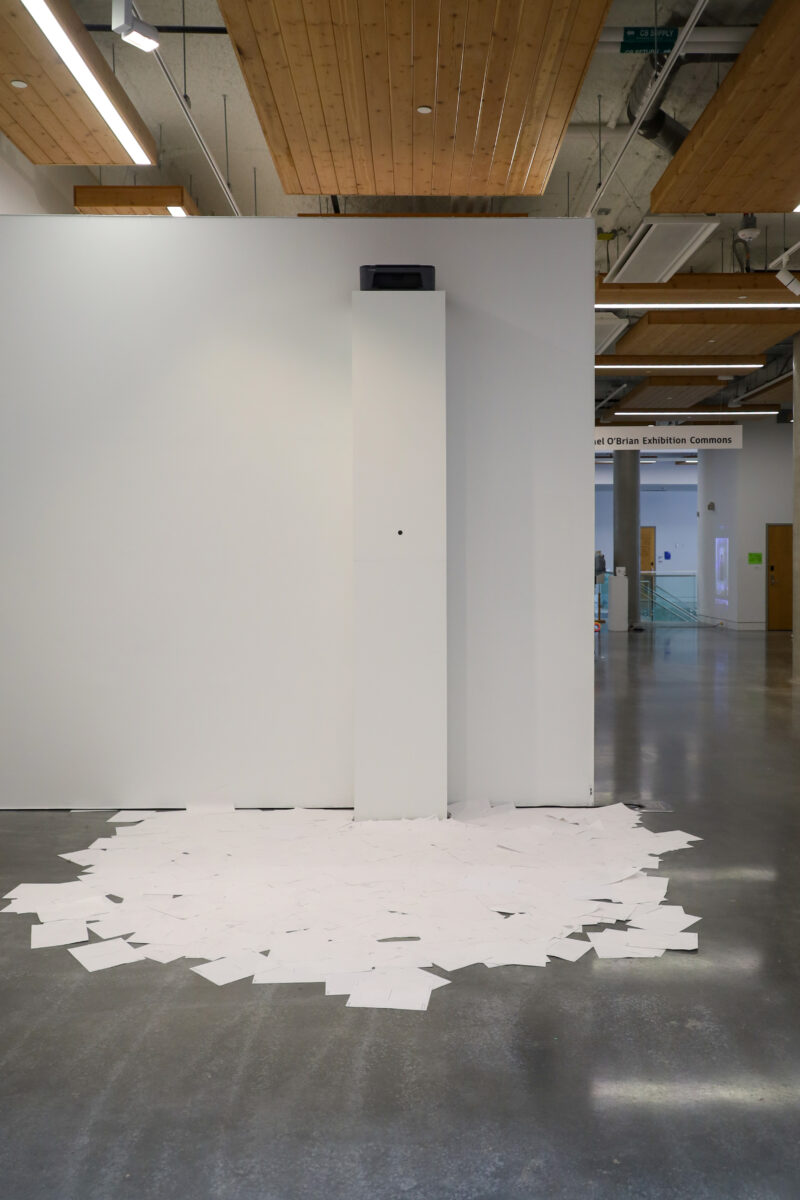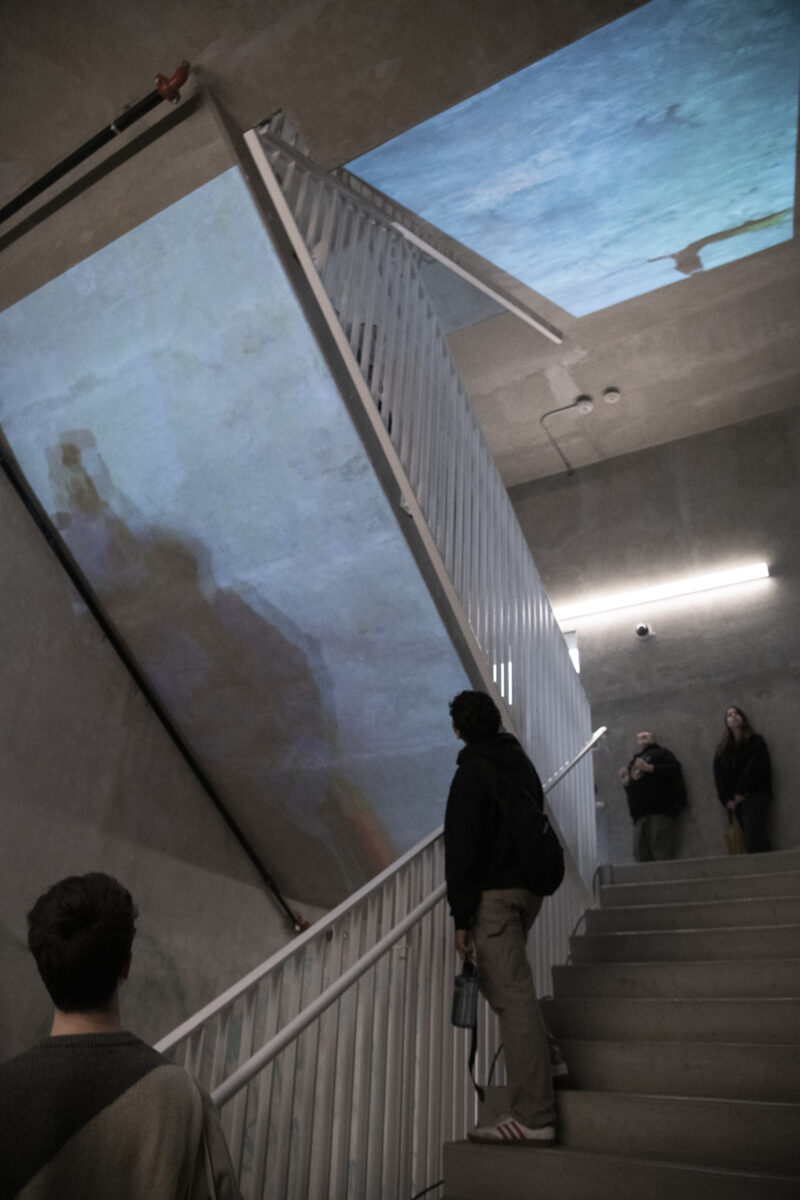April 29, 2024
Presenter Series / Introducing Kyla Dooley : Not that kind of conceptual artist
Written by Emily Carr
On March 20th in The Basically Good Media Lab, we hosted an artist talk by our very own 3rd year NMSA Student and Free Tools Research assistant Kyla Dooley!
In contemporary art, where boundaries are constantly pushed and redefined, Kyla Dooley stands out from the crowds, blending New Media innovation with a playful spirit.
Drawing inspiration from eclectic sources, she meticulously crafts each piece, weaving together elements of humor, and technology. Rejecting the boundaries of traditional categorizations like “conceptual art,” Dooley embraces a label of her own making: “conceptually based”. Rejecting the elitism sometimes associated with contemporary art, she uses humor as both a tool of engagement and a form of protest.
Dooley invites people from diverse backgrounds to join a conversation that goes beyond the gallery walls with her interactive art pieces. For example, her creation ‘the Printer’ acts like an oracle, changing how we see everyday objects, while ‘Fish Move in Three Dimensions’ disrupts the ordinary experience of walking downstairs by turning them into a space for showcasing videos that evoke feelings of melancholy and awareness of our physical movement in three dimensions.
In an interview Kyla explains further her concepts, methods, and allows for a deeper understanding of her art in all its “conceptually based” ways.
K: Your label of “conceptually-based” art is intriguing. Could you elaborate on
what that means to you and how it differs from traditional conceptual art? How
does this label reflect your artistic philosophy and approach?
KD: I think it’s easier to understand the label by talking about what it’s not. For
explanation purposes, I would argue the opposite of a conceptually-based practice
would be a material practice – as in, someone whose work derives from developing
their work hands-on, eg. sketching out forms, testing a medium’s formal capacities,
making lots of things and seeing what sticks, etc. My process, on the other hand, is
largely premeditated before I physically intervene with any of the material I intend to
use. I start with an idea, like “What if a printer was voice-activated?” or “What if there
was art in the stairwell?” and then cater the medium and process to supporting that
idea. That said, I’m not working in a strictly purist conceptual art approach wherein
every detail is laid out ahead of time. I’ll typically have the base idea and then get my
hands on the material and try an approach then come back to the idea, think about
what’s working and what’s not, iterate the material again, and continue this process
until I’m (mostly) satisfied with the work. Alas, “conceptually-based” is the least
pretentious and most accurate term I’ve come to refer to my practice with.

K: Your art seems to challenge conventional perceptions and expectations,
inviting viewers to engage with ordinary objects in unexpected ways. What
drives you to explore these unconventional approaches, and what do you
hope viewers take away from interacting with your pieces?
KD: I think that challenging conventional perceptions and expectations is one of the best
capacities of art (and maybe even one of the qualities that makes something art at
all). If you take the piece I did with the printer as a case study, the reason that piece
works is because I’ve developed an unusual interaction around the object. A printer
that sits in an office is just a printer, but a printer that sits on a ten-foot-tall plinth and
prints out cheeky responses at the beck and call of the audience is a special
experience. It’s unusual and surprising and because of that, gets us thinking and
considering the object with a fresh set of eyes.
For me, it’s a game of push and pull between the expected and unexpected. The
work needs to have some point of recognizability that makes it approachable but in
the same act, do something unusual and extraordinary that sets people out of their
routine.
Each piece has its own political agenda, but broadly speaking, I hope people can
walk away from my art with a renewed sense of the malleability of the world around
us. As artists, we’re in one of the few industries where play is not only encouraged,
but required for the job. It’s a massive privilege to be in that head space and
something I hope I can share even if it’s just for a moment through an art encounter.
K: Can you walk us through your creative process when developing interactive
art pieces like “the Printer” or “Fish Move in Three Dimensions”? How do you
blend humor, technology, and conceptual elements seamlessly in your work?
KD: Sneaky how you’ve woven compliments into these questions – thank you. I briefly
touched on my process above so I’ll focus on the latter half of this question.
Working with each of these individual components – humor, technology, conceptual
elements – was/is rarely a conscious decision. I don’t think we have much say in the
kind of art we make. And by that I mean, I don’t think we have much control in what
we’re interested in. I don’t think I could force myself to be interested in painting if I
tried (though ironically the endeavor in and of itself could be an interesting art
project…). I’m interested in the things that I’m interested in, and I’m gonna make art
that I think is interesting. For me, those endeavours happen to be described as
conceptual and playful but these aren’t attributes I willfully chose one day.
However, I will say, that I have very consciously chosen to put the art first when
making art. I realize this sounds like a redundant statement, but I think there’s a big
push in contemporary art right now to linguistically proclaim virtuosity in art. Aka, the
quality of the art has become inferior to the way you’re writing and talking about it. I
loathe this condition. If an artwork is heavily relying on a written statement to
communicate its “meaning” then the text has superseded the necessity of the
artwork at all. At that point, you may as well just read an essay on the topic since the
art itself isn’t contributing anything.
Within my own practice, I have to be excited about the art as art. If it’s not interesting
to me then why the hell would anyone else care about it? And respectively, I grow
tired of things pretty easily, so that standard of interesting is always in flux.
K: Humor appears to be a central element in your work, serving both as a tool of
engagement and a form of protest against elitism in contemporary art. How do
you navigate the balance between humor and deeper conceptual themes in
your art?
KD: “Humor … as a tool of engagement and a form of protest against elitism in
contemporary art” – damn, I’m gonna steal that line for my next artist statement (I’m
only half kidding). This is a really thoughtful question and insightful analysis. I don’t
think I’ve ever approached a work with humor at fear of it being disregarded as
thematically unsubstantiated because of such qualities. Humor is complicated and
nuanced and that complexity is often prime material to navigate a piece around
conceptually. A good joke is usually a good artwork.
A friend recommended I watch the movie Brazil a couple of months ago (it was
incredible and I would highly recommend it) and afterwards I was reading a review of
the film that cited it as “a superb example of the power of comedy to underscore
serious ideas, even solemn ones”; it was a really validating moment for my practice.
So I wouldn’t say it’s a balancing act, so much as a matter of ensuring the humor is
supporting the concept and vice versa.

K: Your art often extends beyond the confines of the gallery, inviting people from
diverse backgrounds to join a conversation. How do you see the role of
interactive art in fostering community engagement and dialogue, particularly
in today’s digital age?
KD: I think that interactive art, like humor, is a great strategy for making art more
accessible to a broader audience. As you mentioned above, the art world is
ridiculously elitist. Artworks are put behind literal and metaphorical walls and
described in unnecessarily complicated art world jargon; it all sends a very clear
message about who is welcome in those spaces. It’s uncomfortable staring at a
lukewarm oil painting feeling like you don’t get it. But when an artwork is interactive,
there’s immediately an entry point to engage with the work that takes precedence
over the forlorn quest to “get it.” And then once you’ve sustained engagement, you
may actually have a shot at conveying some idea/experience/dialogue. I’m not
saying making art interactive is the only/best way to do this (in fact there’s a lot of
shitty interactive art that doesn’t achieve this) but I do think it’s a particularly pertinent
and effective method, especially within the state of our attention economy.
I’m also a firm believer you can make your work accessible to a broad audience
without sacrificing complex ideas. An elegant example of this duality is Nick Cave’s
Soundsuits.
For more from Kyla, check her artworks @kyladooley on Instagram or at kyladooley.com!

